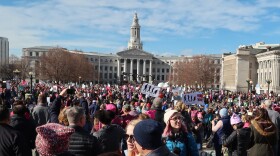Denver’s third annual womxn’s march started much the same way it began in 2017. In the early morning, crowds of marchers bundled in coats and pink hats, flooded into Civic Center Park. Attendance this year didn’t come close to the more than 100,000 people seen three years ago, when 53-year-old Jillian Allison first attended.
“We couldn’t even do the march because it was too crowded to actually do the circuit,” she said.
Officials with the march estimate around 80,000 people came this year. Allison added the lower numbers could be a sign of “protest fatigue.”
But that didn’t impact enthusiasm among the crowds, who led chants and hoisted hundreds of clever protest signs that have become a hallmark of the event.
What began as a response to the election of President Donald Trump, and sparked by a Facebook post, the national women’s march has since struggled to evolve into a cohesive movement for change. This year organizers developed the theme of “listen, unite and act.”

Denver was among several marches, including Seattle and Colorado Springs, to drop the “e” from the spelling of women, replacing it with an “x.” Organizers hoped this would signal a welcome to those who don’t identify as cisgender and female. While it confused some, the change was welcomed by many marchers, including Yuying Tsong, who said it keeps the movement relevant.
“It’s really important to very intentional and thoughtful about being very inclusive, so the women’s march, how do we think about women, right. Is it just cisgender women?” she said.
In an interview with KUNC, Angela Astle with the Denver Women’s March, said this year they’ve tried to make the event more representative. The lineup of speakers included people from indigenous, refugee and immigrant backgrounds, as well as members of the LGBTQ and non-binary communities.
In the first year of the march, said Astle, there wasn’t much time for planning beyond basic logistics. “There wasn't an ability to zoom out and go, who's not here, that should be here as part of the conversation.”
Watching the crowds from a distance, 43-year-old Simone Canaday said she was disappointed by what she described as a low turnout from people of color. Canadey said the ongoing government shutdown is what pushed her to participate for the first time this year but she was questioning who this march was for.

“Is it equality for everybody, or just a certain demographic of women whose rights were promoting?” she said.
This year local non-profit organizations tabled at Civic Center Park with the hope of funneling the collective energy of the march into involvement with a local cause. “I think the power of the march itself is coming together and feeling like you're not alone,” said Astle. “And yet that’s where we've maybe lost people is that people come out and then they march and then they go home.”
As the event wound down, 27-year-old Shelby Black clutched a handful of pamphlets she’d collected.
“I have walked in and out of marches being like ‘ok, that was another thing to do on my list,’” she said. “But there are a few more action items that follow today’s agenda.”
As the womxn’s march looks to the future, both organizers and protesters hope each year builds on who participates — and the impact that comes with it.








